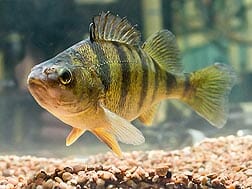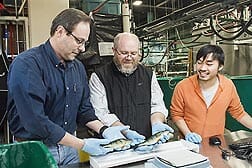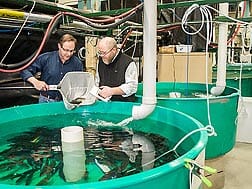
Agricultural Research Service scientists are working closely with the University of Wisconsin-Milwaukee School of Freshwater Sciences to ensure that the aquaculture industry produces enough yellow perch to meet consumer demand. This high-value fish is very low in fat, high in protein and calcium, and has a mild, sweet flavor.
Using traditional breeding methods, scientists in the ARS Dairy Forage and Aquaculture Research Unit are developing genetically improved yellow perch by selecting for faster growth. One challenge has been the difference in growth rate between male and female yellow perch; females tend to grow faster and larger than males. But differences in growth rate alone are not sufficient to identify gender, says ARS fish physiologist Brian Shepherd. If only large fish are selected, there will be a strong bias toward females. The biggest males are also needed, but scientists had been unable to distinguish between smaller females and larger males.
To improve fish performance, scientists must also understand physiological differences between young female and male fish. But since gender identification is difficult until fish mature, it can be challenging to separate them for these kinds of studies.
“For example, if you’re trying to genetically improve cattle, pigs, or sheep, imagine how difficult it would be to separate animals and manage them if you could not tell the sexes apart until they mature,” Shepherd says. “It’s problematic in yellow perch and other fish species.”
Attention to Appearances
Shepherd and his colleagues developed criteria, based on the shape and color of the anal and reproductive openings, to identify the gender of yellow perch during early growth. The step-by-step procedure provides a systematic way to segregate males and females that are 3 inches or more in length. The process is fast, easy, and reliable. It involves an algorithm—a checklist that includes the size of the fish, the shape of specific parts, and other criteria.
The method is more than 97 percent accurate and provides a practical tool to cost-effectively sort females from males, Shepherd says. Gender separation can be used to develop yellow perch brood stocks, conduct gender-specific experiments, and identify the fastest growing females and males for growth performance. “Because fish are unharmed, the algorithm can also be used to distinguish males from females during field surveys,” Shepherd adds.
In the study, scientists examined different geographical strains of yellow perch and considered factors such as maturity and environmental conditions that may affect external characteristics related to gender. They examined yellow perch that were about 3 inches to 11 inches long and identified female and male characteristics that could be confirmed in four distinct geographical strains.
Scientists segregated the fish according to length within each strain and then determined gender based on external appearances. Fish have two openings—the anal and the urogenital—on their abdomen in front of their tails. The shape of the urogenital opening in males is round and generally larger in circumference than the anal opening, whereas females tend to have a V- or U-shaped opening that is smaller in circumference than the anal opening.
“Males usually have a more brownishred coloration of that area than females do, especially when they’re sexually immature,” Shepherd says.
Scientists confirmed gender by looking at the internal gonads of fish. “We had greater than 90 percent accuracy in correlating external gender with the true gender in females,” Shepherd says. “Geographical locations of strains had significant effect on accuracy, so a stepwise checklist [algorithm] was developed to help producers determine whether the criteria would apply to their populations. With our algorithm, we were able to reliably identify the gender of yellow perch that were just 3.1 inches in length. That’s a pretty small fish.”

Without effective gender identification methods, scientists were retaining smaller females thinking they were males. The new system allows them to identify the biggest females and males for producing the next generation of yellow perch.
Determining Disease Resistance
In other research, Shepherd and his colleagues studied the yellow perch’s immune response. Male and female fish were given a compound called “lipopolysaccharide,” which mimics a bacterial infection. The female’s immune response was lower than the male’s, suggesting the females recovered faster or cleared the compound more effectively.
“Though more work is needed, this suggests that females may have a more robust immune system than males,” Shepherd says. “Therefore, we aim to produce all-female yellow perch populations that will grow faster and have greater disease resistance. That should really be a tremendous advantage to producers.”
This research is part of Aquaculture, an ARS national program (#106) described at www.nps.ars.usda.gov.
June 2014

